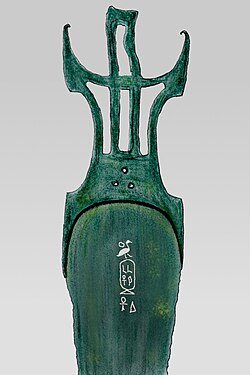Top Qs
Timeline
Chat
Perspective
Bebiankh
Egyptian Pharaoh of the 16th or 17th dynasty From Wikipedia, the free encyclopedia
Remove ads
Seuserenre Bebiankh was a king in Upper Egypt during the Second Intermediate Period. He is often placed in the 16th Theban Dynasty and his prenomen or royal name is mentioned in the Turin King List with a reign of 12 years.
Based on an interpretation of the Turin King List, Bebiankh was succeeded either by a poorly known king named Sekhemre Shedwast.[1] Also suggested is the equally shadowy ruler Seneferankhre Pepi III.[2]
Remove ads
Attestations
Bebiankh is only attested in a small region of Upper Egypt.
At Gebel Zeit (Red Sea), a modest stela preserves his prenomen Seuserenre and nomen Bebiankh, attesting to mining activity in the nearby gelena mines.[3][4][5] Mining expeditions to Gebel Zeit often departed from Coptos (Quft), cf. Minemhat of Coptos.
At Medamud, he built an extension to the Temple of Mentu.[6]
In Naqada, the nomen of Bebiankh is found on a bronze dagger with the inscription: Son of Ra, Bebiankh, given life.[7][1]
Non-contemporary attestations
The Karnak King List from the time of Thutmose III mentions: 27. Se-user-en-re. Here he is between Nubkheperre and Senakhtenre.
The Turin King List 11:08 from the time of Ramesses II mentions: The Dual King Seuserenra reigned 12 years, months lost, x days.[8] In the list he is preceded by 11:07 Semenra and succeeded by 11:09 Sekhemre Shedwaset, often interpreted as chronological.
The name Seuserenre consists of word-components: s-wsr-n-r'
- wsr which means "powerful".[9]
- n can mean "of"
- r' refers to the sun-god Ra.
Remove ads
References
Wikiwand - on
Seamless Wikipedia browsing. On steroids.
Remove ads

